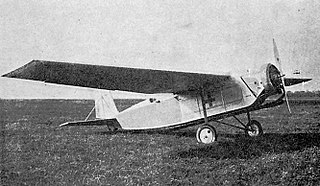
The Latécoère 350 was a trimotor development of the Latécoère 28, a successful single-engined French monoplane of around 1930. The three engines were intended to provide the reliability needed for overnight flights, but the 350 came out very overweight. Only one was built.

The Latécoère 490 was a two-seat, single-engined parasol winged aircraft, designed to a French photographic reconnaissance specification of 1928. Only two prototypes were built.

The Potez 37 was a two-seat, long range reconnaissance aircraft built to compete for a French government contract. It flew in mid-1930 but did not win the competition, so only two were completed.

The Potez 40 was a French three-engine, braced high-wing monoplane designed and built in response to a French government programme for colonial transport and policing aircraft duties.

The Potez 31 was a prototype French two-seat night fighter, flown in about 1928, intended to fill the Cn.2 specification for the Armee de l'Air. Only one was built.

The Les Mureaux 3 C.2 and Les Mureaux 4 C.2 were French two seat, parasol winged fighters, flown in 1927-8, which differed only in their engines. They were developed into near identical army co-operation types, the ANF Les Mureaux 130 A.2 and ANF Les Mureaux 131 A.2, in 1929–31.

The SAB DB-80 and SAB DB-81 were single-engine, all-metal French light transports aimed at the air mail market whilst carrying two passengers. Identical apart from their engines, they flew in mid-1930.

The Potez 50 or Potez 50 A2 was a French two seat military multi-rôle aircraft, first flown in 1931. It did not go into service but seven variants using five different engines were produced, one of them setting several speed with useful load records and another, the Potez 506, setting three altitude world records.

The Wibault 260 R.2 was a contender for a French government contract for a long range, two seat reconnaissance aircraft, issued in 1928. There were eight prototypes in the 1931-2 contest and the Wibault was not selected for production.

The Nieuport-Delage NiD 580 R.2 was a contender for a French government contract for a long range, two seat reconnaissance aircraft, issued in 1928. There were eight prototypes in the 1931-2 contest and the NiD 580 was not selected for production.

The SECM-Amiot 130 R.2 was a contender for a French government contract for a long range, two seat reconnaissance aircraft, issued in 1928. There were eight prototypes in the 1931–32 contest and the Amiot 130 was not selected for production.

The Guillemin JG.40 was designed and built to meet a French government requirement for a small air ambulance capable of operating in the colonies. Two were completed and performed well but the JG.40 did not reach production.

The Guillemin JG.10 or Blériot-Guillemin JG.10 was a French two seat touring aircraft, designed to be as simple and safe to fly and maintain as a car, with similar facilities, as well as provision for parachutes.
The Couzinet 100 was a three-engined, three-seat touring aircraft designed and built in France in 1930. Two variants, the Couzinet 101 and Couzinet 103, were very similar apart from their engines; no variant reached production.

The Hanriot H.34 was a basic trainer designed in France in 1924 which did not reach production. It was a parasol wing aircraft, seating two in tandem.

The Hanriot H.25 was a French, single-engined, six passenger airliner built in 1926. Only one was flown.

The Aviaméta 92 was a French, all-metal, five seat monoplane built in the late 1920s. Three different engines were fitted, and one example flew the first non-stop Paris-Algiers flight in preparation for an abandoned trans-Atlantic attempt.

The Hanriot H.46 Styx was a French, single-engined, parasol wing aircraft which could equally be configured for training, liaison or ambulance roles; in the latter form it was able to accept a patient on a stretcher. Several different engines were fitted and flown but the type did not reach production.

The Bourgois-Sénémaud AT was a parasol wing, two seat touring aircraft built in France in 1928. Three examples were completed.
The Muniz M-5 was the first of Antônio Guedes Muniz's aircraft designs to fly; soon afterwards he became the first Brazilian to design an aircraft which reached series production. The sole example of the M-5, built while he was a student in France by Caudron, was a low wing cabin tourer or military liaison aircraft.


















